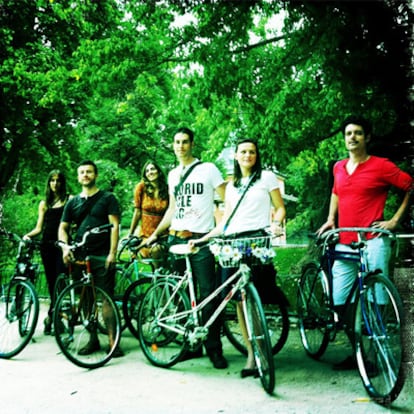Cycling firmly toward the past
Demand for retro bikes is rising, with many opting for personalized designs
It's been nearly 30 years since the onscreen death of Chanquete, a popular character in the 1981 television series Verano azul (or, Blue Summer). But the bicycles he and his friends used to ride are back on the streets: the Motoretta by G.A.C, the Bicicross and the California by BH, and classic designs by Torrot, Orbea and Derbi-Rabasa. It turns out those old chunks of metal, rusting away in people's storage closets, are an uncut diamond for "retrocyclists," people who don't mind a little more weight if the vehicle between their legs has charm.
"I bought Conchita used. She's a Torrot cruiser and probably older than the hills," says Isabel Ramis, a journalist and author of the blog mueveteenbicipormadrid.blogspot.com. Isabel points to a reason for the rise of retro bikes: "New bicycles are tremendously expensive and their design leaves a lot to be desired. When it comes to sports bikes, you've got all the variety you could wish for, but for cruisers, there is little choice."
The craze for retro bikes is not just a Spanish thing. Every country has its own mythical models that are being brought back from oblivion. "In Chile it's the legendary Mini by CIC; in Argentina we have the Auroritas; in the United States there's the Sting Rays by Schwinn; in Britain it's the Chopper by Raleigh," writes Hans Alemany, of www.alemanyretrocycles.cl, in an email.
Hans restores bicycles and also personalizes them to meet his client's tastes, an increasingly popular trend. "I started with the first restoration work in the summer of 2007. Back then many old bikes were viewed as trash, because of the rise of mountain bikes."
But the rust of oblivion and the ultra-light, latest generation models have not managed to break the emotional ties linking today's retro-cyclists with the world of their childhood. These bikes may weigh more, "but they're more comfortable to ride and cheaper, too," say their supporters.
Besides, it's not about getting there first, or swallowing up the miles. It's about following your own pace and style, and defining a different way of life.
Other film references that keep bicycles alive in the collective imagination include the sophisticated actresses of Italian neo-realism and the French nouvelle vague, to 1980s classics like E.T.
Alemany places the beginning of the retro boom in 2009. "We are now restoring and selling around 20 bicycles a month, and growing. To this we have to add the hundreds of parts we sell to people who restore bikes by themselves."
There are also brands that never stopped making their classic models, like the Portuguese Órbita, under whose brand the Miralago group makes the models Eurobici and Sport Confort Classic, both of which have an indisputably classic look. The store Calmera sells around 50 units a month at its Madrid distributor alone, says Aurelio Ferreira, who founded Órbita in 1971. "Our job is maintaining tradition. We are the only company in Europe still making our own frames, following the old system. Other European brands went to China. We keep the traditional models because the market has an interest in it."

Tu suscripción se está usando en otro dispositivo
¿Quieres añadir otro usuario a tu suscripción?
Si continúas leyendo en este dispositivo, no se podrá leer en el otro.
FlechaTu suscripción se está usando en otro dispositivo y solo puedes acceder a EL PAÍS desde un dispositivo a la vez.
Si quieres compartir tu cuenta, cambia tu suscripción a la modalidad Premium, así podrás añadir otro usuario. Cada uno accederá con su propia cuenta de email, lo que os permitirá personalizar vuestra experiencia en EL PAÍS.
¿Tienes una suscripción de empresa? Accede aquí para contratar más cuentas.
En el caso de no saber quién está usando tu cuenta, te recomendamos cambiar tu contraseña aquí.
Si decides continuar compartiendo tu cuenta, este mensaje se mostrará en tu dispositivo y en el de la otra persona que está usando tu cuenta de forma indefinida, afectando a tu experiencia de lectura. Puedes consultar aquí los términos y condiciones de la suscripción digital.
Últimas noticias
Most viewed
- Alain Aspect, Nobel laureate in physics: ‘Einstein was so smart that he would have had to recognize quantum entanglement’
- Maps of the US attack on Venezuela: Targets, airspace and deployed fleet
- David King, chemist: ‘There are scientists studying how to cool the planet; nobody should stop these experiments from happening’
- Key points of the military attack on Venezuela: Early morning bombings and a ‘captured’ president
- Maduro jailed in New York after his capture in Caracas








































